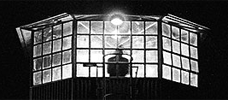Reviews
Sven Gade and Heinz Schall
Germany, 1921
Credits
Review by Jenny Jediny
Posted on 01 October 2007
Source Deutsche Filminstitut 35mm print
Categories The 45th New York Film Festival
Vengeance as a woman or a prince? This 1921 version of Hamlet, starring Danish silent screen goddess Asta Nielsen, poses that intriguing question. Originally created and supported through Nielsen’s own production company, this interpretation of Shakespeare’s tragedy proposes that Hamlet was in fact a woman, forced by her family from birth to disguise herself as a man in order to inherit the throne. Basing this twist on an 1881 text entitled The Mystery of Hamlet, written by Edward P. Vining, there are implications of Hamlet as a ‘womanly man,’ tortured not only by her hidden sex, but according to 19th century beliefs, her feminine inability to either actively seek vengeance or make firm, i.e., masculine, decisions.
While Nielsen’s portrayal specifically picks up on Hamlet’s famous indecision, there is little to imply that her concealed female identity renders her weak. Certainly since Vining published his text, literary and film interpretations of Hamlet’s vacillating nature are far more favorable (the prelude in the 1921 Hamlet references attacks on the Dane, such as Goethe declaring Hamlet an ass), enabling us to now revel in Nielsen’s vivid, nuanced performance. Lithe and slender, Nielsen’s facial features are as striking as Garbo’s, while her body language as Hamlet is as self-aware as Tilda Swinton maneuvering between sexes in the more recent Orlando.
As Hamlet’s indecision is now underlined with gender confusion, there are further complications of a more sexual nature; Hamlet finds herself romantically attracted to Horatio, who in turn develops feelings for Ophelia. A messy love triangle forms, and Hamlet’s mental toying with Ophelia’s feelings is now provoked through jealousy, while Hamlet and Horatio’s frequent embraces and caressing simultaneously evoke a queer subtext. It’s a fascinating interpretation, enhanced by added scenes of Hamlet at university; a bond develops not only with Horatio but also between Hamlet and Fortinbras, also encouraging a gay interpretation, as Fortinbras practically lights up when Hamlet enters the room.
While Hamlet contends with these various degrees of sexual confusion, her determination for vengeance grows with her anger over her male façade. Gertrude, who bears the brunt of Hamlet’s familial fury in the play, suffers the same wrath here but to a larger degree, as Hamlet not only suspects her role in the king’s murder, but also blames her for her inability to fully be either a woman or a man. Spite is evident on Nielsen’s face when Hamlet finally confronts her mother, who shows little care or concern; Gertrude is lustful and power-hungry, and it is she, not Claudius, who plots to poison Hamlet’s goblet for the final duel. This further alteration of the original text increases not only the tension between mother and ‘son,’ but also underlines the increased emotional complexity of the women in the play.
Oddly, the intertitles and dialogue take little from the actual Shakespearean text, instead using crude direction and dialogue to move the action along. While it’s a pity not to have the verse available, if only in readable form, Hamlet is already such a radical departure that it’s readily acceptable in light of adaptations that modernize the text or dramatically alter time or setting. Full credit deservedly goes to Nielsen for the film’s success, as her embodiment of the tragic prince is as visually exciting as it is provocative for its time period; her melancholy yet astute prince seems as aware of not merely the character’s place in history, but her own unforgettable performance.
More The 45th New York Film Festival
-

The Darjeeling Limited
2007 -

Hamlet
1921 -

The Romance of Astrea and Celadon
2007 -

Secret Sunshine
2007 -

Paranoid Park
2007 -

Alexandra
2007 -

Before the Devil Knows You’re Dead
2007 -

The Diving Bell and the Butterfly
2007 -

The Last Mistress
2007 -

The Man from London
2007 -

I’m Not There
2007
We don’t do comments anymore, but you may contact us here or find us on Twitter or Facebook.



